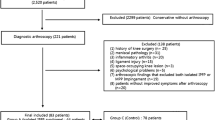Abstract
Objective
To look for any association between oedema in the superolateral portion of the infrapatellar fat pad and patellar maltracking.
Materials and methods
We compared two groups of knee MRI with regard to five patellar maltracking parameters. The first group included 100 knees with evidence of oedema in the superolateral aspect of the infrapatellar fat pad (the study group). The second group included another 100 knee MRI that had a normal infrapatellar fat pad (the control group). The five patellar maltracking parameters assessed were the trochlear depth, tibial tuberosity–trochlear groove distance (TTTG), patellar translation, patellofemoral angle (PFA) and the Insall–Salvati index.
Results
There was a statistically significant difference in the Insall–Salvati index, patellar translation and PFA between the two groups (p value of <0.001, <0.001 and 0.004 respectively, Student’s t test). There was a higher prevalence of patella alta, lateral patellar displacement (LPD) and lateral patellar tilt in the study group (p value of <0.001, <0.001 and 0.011 respectively, Fisher’s exact test). Sixty out of 100 knees in the study group had at least one abnormal patellar maltracking parameter in comparison to 16 out of 100 knees in the control group (p < 0.001, Fisher’s exact test).
Conclusion
Oedema in the superolateral portion of Hoffa’s fat pad, the MRI feature of fat pad impingement, is associated with patellar maltracking.






Similar content being viewed by others
References
Hoffa A. The influence of adipose tissue with regard to pathology of the knee joint. JAMA. 1904;43:795–6.
Dye SF, Vaupel GL, Dye CC. Conscious neurosensory mapping of the internal structures of the human knee without intra-articular anesthesia. Am J Sports Med. 1998;26:773–7.
Biedert RM, Sanchis-Alfonso V. Sources of anterior knee pain. Clin Sports Med. 2002;21:335–47.
Chung CB, Skaf A, Roger B, Campos J, Stump X, Resnick D. Patellar tendon-lateral femoral condyle friction syndrome: MR imaging in 42 patients. Skeletal Radiol. 2001;30:694–7.
Subhawong TK, Eng J, Carrino JA, Chhabra A. Superolateral Hoffa’s fat pad edema: association with patellofemoral maltracking. AJR Am J Roentgenol. 2010;195:1367–73.
Brossmann J, Muhle C, Schröder C, et al. Patellar tracking patterns during active and passive knee extension: evaluation with motion-triggered cine MR imaging. Radiology. 1993;187:205–12.
Wittstein JR, Bartlett EC, Easterbrook J, Byrd JC. Magnetic resonance imaging evaluation of patellofemoral malalignment. Arthroscopy. 2006;22:643–9.
Pfirrmann CW, Zanetti M, Romero J, Hodler J. Femoral trochlear dysplasia: MR findings. Radiology. 2000;216:858–64.
Laurin CA, Dussault R, Levesque HP. The tangential x-ray investigation of the patellofemoral joint: x-ray technique, diagnostic criteria and their interpretation. Clin Orthop Relat Res. 1979;144:16–26.
Koskinen SK, Taimela S, Nelimarkka O, Komu M, Kujala UM. Magnetic resonance imaging of patellofemoral relationships. Skeletal Radiol. 1993;22:403–10.
Diederichs G, Issever AS, Scheffler S. MR imaging of patellar instability: injury patterns and assessment of risk factors. Radiographics. 2010;30:961–81.
McNally EG. Imaging assessment of anterior knee pain and patellar maltracking. Skeletal Radiol. 2001;30:484–95.
Miller TT, Staron RB, Feldman F. Patellar height on sagittal MR imaging of the knee. AJR Am J Roentgenol. 1996;167:339–41.
Walsh WM. Patellar tracking problems in athletes. Prim Care. 1992;19:303–30.
Bergman AG, Fredericson M. MR imaging of stress reactions, muscle injuries, and other overuse injuries in runners. MRI Clin North Am. 1999;7:151–74.
Ward SR, Terk MR, Powers CM. Patella alta: association with patellofemoral alignment and changes in contact area during weight-bearing. J Bone Joint Surg Am. 2007;89(8):1749–55.
McNally EG, Ostlere SJ, Pal C, Phillips A, Reid H, Dodd C. Assessment of patellar maltracking using combined static and dynamic MRI. Eur Radiol. 2000;10(7):1051–5.
Escala JS, Mellado JM, Olona M, Giné J, Saurí A, Neyret P. Objective patellar instability: MR-based quantitative assessment of potentially associated anatomical features. Knee Surg Sports Traumatol Arthrosc. 2006;14(3):264–72.
Harbaugh CM, Wilson NA, Sheehan FT. Correlating femoral shape with patellar kinematics in patients with patellofemoral pain. J Orthop Res. 2010;28(7):865–72.
Dejour H, Walch G, Nove-Josserand L, Guier C. Factors of patellar instability: an anatomic radiographic study. Knee Surg Sports Traumatol Arthrosc. 1994;2(1):19–26.
Schoettle PB, Zanetti M, Seifert B, Pfirrmann CW, Fucentese SF, Romero J. The tibial tuberosity-trochlear groove distance: a comparative study between CT and MRI scanning. Knee. 2006;13(1):26–31.
Tsujimoto L, Kurosaka M, Yoshiya S, Mizuno K. Radiographic and computed tomographic analysis of the position of the tibial tubercle in recurrent dislocation and subluxation of the patella. Am J Knee Surg. 2000;13(2):83–8.
Pandit S, Frampton C, Stoddart J, Lynskey T. Magnetic resonance imaging assessment of tibial tuberosity-trochlear groove distance: normal values for males and females. Int Orthop. 2011; DOI: 10.1007/s00264-011-1240-8
Mulford JS, Wakeley CJ, Eldridge JD. Assessment and management of chronic patellofemoral instability. J Bone Joint Surg Br. 2007;89(6):709–16.
Conflict of interest
The authors declare that they have no conflict of interest.
Author information
Authors and Affiliations
Corresponding author
Rights and permissions
About this article
Cite this article
Jibri, Z., Martin, D., Mansour, R. et al. The association of infrapatellar fat pad oedema with patellar maltracking: a case–control study. Skeletal Radiol 41, 925–931 (2012). https://doi.org/10.1007/s00256-011-1299-8
Received:
Revised:
Accepted:
Published:
Issue Date:
DOI: https://doi.org/10.1007/s00256-011-1299-8




